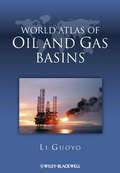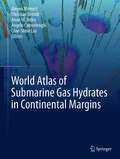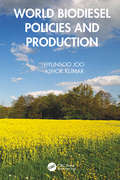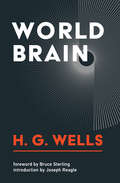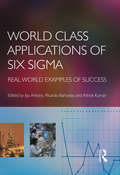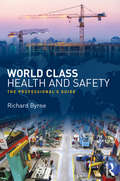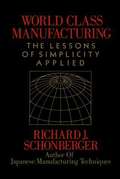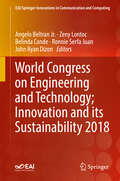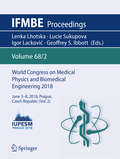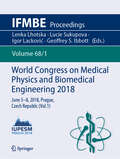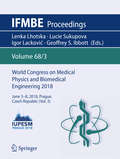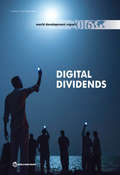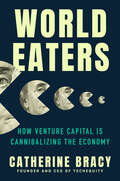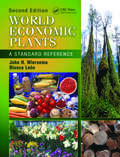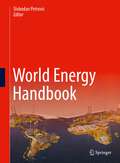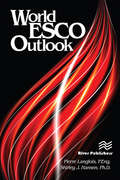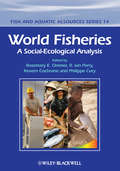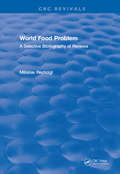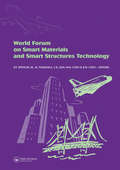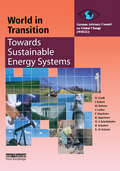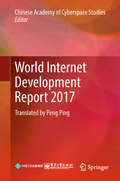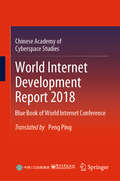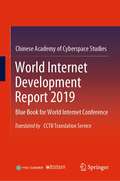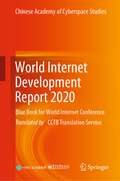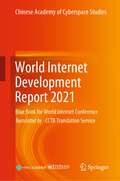- Table View
- List View
World Atlas of Oil and Gas Basins
by Guoyu LiProfessor Li’s World Atlas of Oil and Gas Basins is a fresh and comprehensive treatise of the distribution of the world’s hydrocarbon reserves. The Atlas highlights the geographical, sedimentary and geological features of the basins, using a combination of maps and stratigraphic diagrams to depict the history, prospectivity and commercial production capacity of the reserves on a continental and country-by-country basis. The Atlas is an essential reference source for petroleum geologists and reservoir engineers working in hydrocarbon exploration and production. It is also a valuable and original teaching aid for university graduate and postgraduate courses. The Atlas provides a welcome addition to the global database of the world’s energy resources and is therefore an indispensable source of information for the formulation of future strategies to exploit oil and gas reserves. Written by one of China’s foremost petroleum geologists, the Atlas provides a rare analysis of the industry from the perspective of the country whose demand for oil and gas is set to become the largest in the next few decades. It is an important and vital scholarly work.
World Atlas of Submarine Gas Hydrates in Continental Margins
by Christian Berndt Jürgen Mienert Anne M. Tréhu Angelo Camerlenghi Char-Shine LiuThis world atlas presents a comprehensive overview of the gas-hydrate systems of our planet with contributions from esteemed international researchers from academia, governmental institutions and hydrocarbon industries. The book illustrates, describes and discusses gas hydrate systems, their geophysical evidence and their future prospects for climate change and continental margin geohazards from passive to active margins. This includes passive volcanic to non-volcanic margins including glaciated and non-glaciated margins from high to low latitudes. Shallow submarine gas hydrates allow a glimpse into the past from the Last Glacial Maximum (LGM) to modern environmental conditions to predict potential changes in future stability conditions while deep submarine gas hydrates remained more stable. This demonstrates their potential for rapid reactions for some gas hydrate provinces to a warming world, as well as helping to identify future prospects for environmental research. Three-dimensional and high-resolution seismic imaging technologies provide new insights into fluid flow systems in continental margins, enabling the identification of gas and gas escape routes to the seabed within gas hydrate environments, where seabed habitats may flourish. The volume contains a method section detailing the seismic imaging and logging while drilling techniques used to characterize gas hydrates and related dynamic processes in the sub seabed.This book is unique, as it goes well beyond the geophysical monograph series of natural gas hydrates and textbooks on marine geophysics. It also emphasizes the potential for gas hydrate research across a variety of disciplines.Observations of bottom simulating reflectors (BSRs) in 2D and 3D seismic reflection data combined with velocity analysis, electromagnetic investigations and gas-hydrate stability zone (GHSZ) modelling, provide the necessary insights for academic interests and hydrocarbon industries to understand the potential extent and volume of gas hydrates in a wide range of tectonic settings of continental margins. Gas hydrates control the largest and most dynamic reservoir of global carbon. Especially 4D, 3D seismic but also 2D seismic data provide compelling sub-seabed images of their dynamical behavior. Sub-seabed imaging techniques increase our understanding of the controlling mechanisms for the distribution and migration of gas before it enters the gas-hydrate stability zone. As methane hydrate stability depends mainly on pressure, temperature, gas composition and pore water chemistry, gas hydrates are usually found in ocean margin settings where water depth is more than 300 m and gas migrates upward from deeper geological formations. This highly dynamic environment may precondition the stability of continental slopes as evidenced by geohazards and gas expelled from the sea floor. This book provides new insights into variations in the character and existence of gas hydrates and BSRs in various geological environments, as well as their dynamics. The potentially dynamic behavior of this natural carbon system in a warming world, its current and future impacts on a variety of Earth environments can now be adequately evaluated by using the information provided in the world atlas. This book is relevant for students, researchers, governmental agencies and oil and gas professionals. Some familiarity with seismic data and some basic understanding of geology and tectonics are recommended.
World Biodiesel Policies and Production
by Hyunsoo Joo Ashok KumarThis book presents the evolution of biodiesel technologies along with government policies of major biodiesel producing countries with their backgrounds, impacts, changes, and other energy forms. Biodiesel feedstock and biodiesel production technologies including green algae and methanol are presented as separate topics. Changes in the feedstock types and the corresponding technologies are presented, and their impacts on the biodiesel policies are explained. The life cycle analysis (LCA) in research and policy design of biodiesel is discussed and the findings are given for different feedstocks in terms of greenhouse gases, energy, and other impact categories.
World Brain
by H.G. WellsIn 1937, H. G. Wells proposed a predigital, freely available World Encyclopedia to represent a civilization-saving World Brain.In a series of talks and essays in 1937, H. G. Wells proselytized for what he called a "World Brain," as manifested in a World Encyclopedia--a repository of scientifically established knowledge--that would spread enlightenment around the world and lead to world peace. Wells, known to readers today as the author of The War of the Worlds and other science fiction classics, was imagining something like a predigital Wikipedia. The World Encyclopedia would provide a summary of verified reality (in about forty volumes); it would be widely available, free of copyright, and utilize the latest technology. Of course, as Bruce Sterling points out in the foreword to this edition of Wells's work, the World Brain didn't happen; the internet did. And yet, Wells anticipated aspects of the internet, envisioning the World Brain as a technical system of networked knowledge (in Sterling's words, a "hypothetical super-gadget"). Wells's optimism about the power of information might strike readers today as naïvely utopian, but possibly also inspirational.
World Class Applications of Six Sigma
by Ashok Kumar Jiju Antony Ricardo BañuelasWorld Class Applications shows what real organisations have done to implement Six Sigma, the methodology used, and the results delivered. The book provides details of how these organisations overcame issues with the statistical tools of Six Sigma and provides valuable lessons by explaining what went wrong when implementation failed. Cases cover topics including: Six Sigma in HR; Implementing Six Sigma in the Dow Chemical company; Six Sigma in IT; and Six Sigma to improve reporting quality.
World Class Health and Safety: The professional's guide
by Richard ByrneGetting your qualification is just the start of the safety professional’s journey towards effective workplace practice. World Class Health and Safety doesn’t repeat the whys and whats of health and safety management, instead it is a helpful how-to guide for newly qualified and experienced health and safety professionals to get the best out of their knowledge, experience and the people they work with. This book is filled with practical examples that bring the subject to life, covering the skills and techniques you need to be a leader of safety, overcome inaction and make lasting positive changes to safety performance and culture – enabling more people to go home safe every day. World Class Health and Safety teaches the reader to: work efficiently and effectively with senior managers and budget holders to implement the wider corporate social responsibility agenda emphasize the ‘value-added’ benefits of good health and safety management clearly and simply create effective and engaging training use monitoring and audits to get the best out of the resources available World Class Health and Safety is essential reading for those wishing to invest in their own professional development, to communicate effectively and to understand and deliver safety in the wider business context, wherever in the world they might be working.
World Class Manufacturing: The Lessons of Simplicity Applied
by Richard J. SchonbergerOffers a demystified explanation of the simple techniques that have fueled Japan's industrial success
World Congress on Engineering and Technology; Innovation and its Sustainability 2018 (EAI/Springer Innovations in Communication and Computing)
by Angelo Beltran Jr. Zeny Lontoc Belinda Conde Ronnie Serfa Juan John Ryan DizonThe book presents the proceedings of the World Congress on Engineering and Technology, Innovation and its Sustainability (WCETIS 2018), which took place on November 28-29, 2018 in Manila, Philippines. The conference featured the following tracks: Industrial Engineering and Healthcare, Sustainable Infrastructure; Water Resources Planning and Management; Heat transfer and fluids; Electronics and Electrical Engineering; and Internet of Things. Papers stem from academia and industry throughout the world, showing a variety of perspectives.Presents the proceedings of the World Congress on Engineering and Technology, Innovation and its Sustainability (WCETIS 2018), November 28-29, 2018 in Manila, PhilippinesShows how engineering and technology serve to support a variety for industries from manufacturing to water resourcesFeatures papers from a variety of researchers and developers from around the world
World Congress on Medical Physics and Biomedical Engineering 2018: June 3-8, 2018, Prague, Czech Republic (vol. 2) (IFMBE Proceedings #68/2)
by Geoffrey S. Ibbott Lenka Lhotska Lucie Sukupova Igor LackovićThis book (vol. 2) presents the proceedings of the IUPESM World Congress on Biomedical Engineering and Medical Physics, a triennially organized joint meeting of medical physicists, biomedical engineers and adjoining health care professionals. Besides the purely scientific and technological topics, the 2018 Congress will also focus on other aspects of professional involvement in health care, such as education and training, accreditation and certification, health technology assessment and patient safety. The IUPESM meeting is an important forum for medical physicists and biomedical engineers in medicine and healthcare learn and share knowledge, and discuss the latest research outcomes and technological advancements as well as new ideas in both medical physics and biomedical engineering field.
World Congress on Medical Physics and Biomedical Engineering 2018: June 3-8, 2018, Prague, Czech Republic (vol. 2) (IFMBE Proceedings #68/2)
by Geoffrey S. Ibbott Lenka Lhotska Lucie Sukupova Igor LackovićThis book (vol. 1) presents the proceedings of the IUPESM World Congress on Biomedical Engineering and Medical Physics, a triennially organized joint meeting of medical physicists, biomedical engineers and adjoining health care professionals. Besides the purely scientific and technological topics, the 2018 Congress will also focus on other aspects of professional involvement in health care, such as education and training, accreditation and certification, health technology assessment and patient safety. The IUPESM meeting is an important forum for medical physicists and biomedical engineers in medicine and healthcare learn and share knowledge, and discuss the latest research outcomes and technological advancements as well as new ideas in both medical physics and biomedical engineering field.
World Congress on Medical Physics and Biomedical Engineering 2018: June 3-8, 2018, Prague, Czech Republic (vol. 2) (IFMBE Proceedings #68/2)
by Lenka Lhotska Lucie Sukupova Igor Lacković Geoffrey S. IbbottThis book (vol. 3) presents the proceedings of the IUPESM World Congress on Biomedical Engineering and Medical Physics, a triennially organized joint meeting of medical physicists, biomedical engineers and adjoining health care professionals. Besides the purely scientific and technological topics, the 2018 Congress will also focus on other aspects of professional involvement in health care, such as education and training, accreditation and certification, health technology assessment and patient safety. The IUPESM meeting is an important forum for medical physicists and biomedical engineers in medicine and healthcare learn and share knowledge, and discuss the latest research outcomes and technological advancements as well as new ideas in both medical physics and biomedical engineering field.
World Development Report 2016
by World Bank GroupDigital technologies are spreading rapidly, but digital dividends--the broader benefits of faster growth, more jobs, and better services--are not. If more than 40 percent of adults in East Africa pay their utility bills using a mobile phone, why can't others around the world do the same? If 8 million entrepreneurs in China--one third of them women--can use an e-commerce platform to export goods to 120 countries, why can't entrepreneurs elsewhere achieve the same global reach? And if India can provide unique digital identification to 1 billion people in five years, and thereby reduce corruption by billions of dollars, why can't other countries replicate its success? Indeed, what's holding back countries from realizing the profound and transformational effects that digital technologies are supposed to deliver? Two main reasons. First, nearly 60 percent of the world's population are still offline and can't participate in the digital economy in any meaningful way. Second, and more important, the benefits of digital technologies can be offset by growing risks. Startups can disrupt incumbents, but not when vested interests and regulatory uncertainty obstruct competition and the entry of new firms. Employment opportunities may be greater, but not when the labor market is polarized. The internet can be a platform for universal empowerment, but not when it becomes a tool for state control and elite capture. The World Development Report 2016 shows that while the digital revolution has forged ahead, its "analog complements ?--the regulations that promote entry and competition, the skills that enable workers to access and then leverage the new economy, and the institutions that are accountable to citizens--have not kept pace. And when these analog complements to digital investments are absent, the development impact can be disappointing. What, then, should countries do? They should formulate digital development strategies that are much broader than current information and communication technology (ICT) strategies. They should create a policy and institutional environment for technology that fosters the greatest benefits. In short, they need to build a strong analog foundation to deliver digital dividends to everyone, everywhere.
World Eaters: How Venture Capital is Cannibalizing the Economy
by Catherine BracyAn urgent and illuminating perspective that offers a window into how the most pernicious aspects of the venture capital ethos is reaching all areas of our lives, into everything from healthcare to food to entertainment to the labor market and leaving a trail of destruction in its wake. The venture capital playbook is causing unique harms to society. And in World Eaters, Catherine Bracy offers a window into the pernicious aspects of VC and shows us how its bad practices are bleeding into all industries, undermining the labor and housing markets and posing unique dangers to the economy at large. VC&’s creates a wide, powerful wake that impacts the average consumer just as much as it does investors and entrepreneurs. In researching this book, Bracy has interviewed founders, fund managers, contract and temp workers in the gig economy, and Limited Partners across the landscape. She learned that the current VC model is not a good fit for the majority of start-ups, and yet, there are too few options for early stage funding outside of VC dollars. And while there are some alternative paths for sustainable, responsible growth, without the help of regulators, there is not much motivation to drive investors from the roulette table that is venture capital. World Eaters is an eye-opening account of the ways that the values of contemporary venture capital hurt founders, consumers, and the market. Bracy&’s clear-eyed debut is a must-read for fans of Winners Take All, Super Pumped, and Brotopia, an appealing &“insider / outsider&” perspective on Silicon Valley, and those who are fascinated to look under the hood and learn why the modern economy is not working for most of us.
World Economic Plants: A Standard Reference, Second Edition
by John H. Wiersema Blanca LeónProviding a means for international standardization, this comprehensive reference compiles essential information for more than 12,000 vascular plants of commercial importance throughout the world. For each plant, the text presents the accepted scientific name, synonyms, common names, economic uses, and geographical information. Reviewed by 150 taxonomic and agricultural experts, the second edition includes 2,700 plants that are new to this edition as well as 4,000 additional economic uses. It also incorporates more than 10,000 additional common names in various languages.
World Energy Handbook
by Slobodan PetrovicWorld Energy Handbook presents an overview of the energy systems of selected countries in Africa, Asia, the Americas, and Europe. It is a complete guide to energy history and generation in these countries, including renewable energy, storage, and use. The authors follow the same analytical approach for each country to construct comprehensive surveys of all aspects of energy systems, examining the advantages and disadvantages of each country’s energy infrastructures. The handbook aims to raise awareness about the condition and deficiencies of energy systems in developing countries, and the potential for the countries to improve, grow, and advance the technologies for energy generation – especially by turning to renewable energy sources to increase energy storage capacities and optimizing the way subsystems are integrated. The book serves as a must-have guide for decision-makers, investors, business people, and other professionals to understand the global distribution of energy generation, transmission, and each country’s carbon footprint and identify opportunities for energy system improvement worldwide.
World ESCO Outlook
by Shirley J. Hansen Pierre LangloisAs country after country around the world embraces the idea of self-funding energy efficiency, an energy performance contracting (EPC) model emerges and then changes to meet local needs. World ESCO Outlook captures this rapidly changing landscape, and offers valuable insights into this fascinating and important industry. The authors have brought together the best of in-country experts from nearly 60 countries to share their knowledge and experience as to what makes EPC successful in their specific environments. In telling their story, they also reveal some exciting new overseas market opportunities, and provide the most complete picture available of today's ESCO world. EPC offers the tools and answers to get energy saving projects going. Energy efficiency is the most cost effective way to reduce pollution and, at the same time, make money. EPC brings these goals together by making future energy savings available now to meet energy and environmental needs with guaranteed results.
World Fisheries: A Social-Ecological Analysis (Fish And Aquatic Resources Ser.)
by Rosemary Ommer Ian Perry Kevern L. Cochrane Philippe CuryThis exciting new book grew out of an international symposium held at FAO, Rome in July 2008, but it is not just a collection of papers from that symposium. Rather, the publication brings together work on social-ecological marine research that cuts across disciplines, identifies key common elements and approaches that promote resilience of marine social-ecological systems in the face of global changes, and points to next steps. The book comprises contributions on conceptual issues relating to social-ecological responses in marine systems to global changes; offers illustrative case studies of specific examples of social-ecological responses in marine systems to significant environmental changes manifested locally; develops a syntheses between natural and social scientists on the topic, and points the way forward with innovative approaches to the use of science and knowledge in management, policy and advice. World Fisheries is part of Wiley-Blackwell's prestigious Fish and Aquatic Resources Series, and encompasses chapters from many scientists at the top of their fields worldwide. Carefully drawn together and edited by four world experts in the area, World Fisheries is a landmark publication which is an essential purchase for all fisheries managers worldwide.
World Food Problem
by Professor Miloslav RechciglThe aim of this publication is to provide the interested reader with an authoritative and comprehensive up-to-date bibliography on all important facets of the world food problem, encompassing such questions as the availability of natural reseources, the present and future sources of energy, environmental quality, population growth, world malnutrition, the state of food production, food consumption patterns, future food needs, toxicological aspects of food, agricultural and industrial aspects of food production, and family planning. It is the first compilation of its kind in that it covers the subject from a multidisciplinary point of view, including publications that deal with teh description and alaysis of the world food problem as well as those that offer alternative strategies adn specific technological meaures for alleviating the problem.
World Forum on Smart Materials and Smart Structures Technology: Proceedings of SMSST'07, World Forum on Smart Materials and Smart Structures Technology (SMSST'07), China, 22-27 May, 2007
by B. F. Spencer Jr. M. Tomizuka C. B. Yun W. M. Chen R. W. ChenResearch in smart materials and structures seeks to apply multifunctional capabilities of new and existing materials to develop structures and systems that are capable of self-sensing and monitoring, self-diagnosis and prognosis with intelligence, self-healing and repair, and adaptive response to prevent loss of human life and catastrophe, to minimize maintenance and life-cycle costs, and to prolong service life. This book provides the critical knowledge and technological bases required for meeting one of the ultimate engineering challenges: the design and construction of smart structures and systems.
World in Transition: Towards Sustainable Energy Systems
by German AdvisoryWorld in Transition: Towards Sustainable Energy Systems underscores the urgent need to transform global energy systems so that the world's population has access to energy based on renewable sources. This is necessary to protect the global climate and to free those in developing countries trapped by energy poverty. Such an approach would also yield a peace dividend by reducing dependence upon regionally concentrated oil reserves. The authors stress that such a reconfiguration of energy systems is both feasible and fundable if rapid and resolute action is taken in the coming two decades. To this end, they propose a roadmap with specific milestones, making this an indispensable contribution to the scientific and policy debates on these critical issues and essential reading for those engaged with them.
World Internet Development Report 2017: Translated by Peng Ping
by Chinese Academy of Cyberspace StudiesAn important outcome of the Fourth World Internet Conference, this book provides a comprehensive account of the status quo and trends in global Internet development. Covering network infrastructure, information technology, digital economy, e-governance, cyber security, and international cyberspace governance, it presents the Global Internet Development Index System to assess the Internet development of various major countries and emerging economies.
World Internet Development Report 2018: Blue Book of World Internet Conference
by Chinese Academy of Cyberspace StudiesThis book is an important outcome of the Fifth World Internet Conference. It provides a comprehensive account of the new trends and highlights of global Internet development over the past year, covering network infrastructure, information technology, digital economy, world internet media, cyber security, and international cyberspace governance. This year, the book improves the Global Internet Development Index System and adds more countries into the assessed list, in order to reflect more comprehensively, objectively and accurately the general situation of the world Internet development and thus to provide reference for all countries in promoting Internet development and governance.
World Internet Development Report 2019: Blue Book for World Internet Conference, Translated by CCTB Translation Service
by Chinese Academy of Cyberspace StudiesThis book systematically reviews world Internet development over the past 50 years, and comprehensively discusses the great contributions it has made to economic and social advances. Further, it describes the development, status and trends related to the Internet in major countries around the globe in 2019, and provides an in-depth analysis of the latest conditions, dynamics and development trends in key areas, including information infrastructure, information technology, digital economy, digital government, Internet media, cyberspace security, and international cyberspace governance. Moreover, the book further modifies and enhances the Global Internet Development Index System, in order to better show the Internet development strengths and advantages in various countries, and to reflect the global development trends more comprehensively, accurately and objectively. This book reviews the significant developments and summarizes the lessons learned as well as the future challenges. From a global perspective, it offers a vision of building a community with a shared future in cyberspace based on the new concepts, new ideas and new achievements of various countries participating in cyberspace development and construction. As such it is a valuable reference resource for anyone working in Internet related fields, such as those in government departments, internet enterprises, scientific research institutions, colleges and universities wanting to fully understand world Internet development.
World Internet Development Report 2020: Blue Book for World Internet Conference
by Chinese Academy of Cyberspace StudiesThis book systematically reviews the development process of the world Internet and comprehensively reveals the great contributions of the Internet to economic development and social progress. The world today is marked by changes unseen in a century, and Internet development is facing new opportunities and challenges. In 2020, the COVID-19 epidemic broke out and spread at the global scale, which enormously impacted the global economy and society. Internet played an increasingly important role.Meanwhile, based on the development status of the global Internet, this book fully reflects the development process, status and trend of the world Internet in 2020, systematically summarizes the development status and highlights of the Internet in the major countries around the world, and makes an in-depth analysis of the new conditions, new dynamics and new trends of the development in the key Internet fields; the contents cover the information infrastructure, information technology, digital economy, digital government, internet media, network security, and international cyberspace governance, and other aspects. Moreover, this book further adjusts and enriches the development index systems of the world Internet, in the hope of better showing the development strength and development advantages of the Internet in various countries, and reflecting the overall development trend of the world Internet more comprehensively, accurately and objectively.From an objective perspective, this book collects the latest research results in the global internet field, featuring comprehensive contents and highlights; from a historical perspective, this book reviews the significant development process of the global internet, summarizes the experience and faces the future; from a global perspective, this book tries to construct the cyberspace community with a common future based on the new concepts, new ideas and new achievements of various countries in participating in cyberspace development and construction. This book provides an important reference value for employees in Internet fields, such as government departments, Internet enterprises, scientific research institutions, colleges and universities, to fully understand and master the development of the world internet.
World Internet Development Report 2021: Blue Book for World Internet Conference
by Publishing House of Electronics IndustryThis book objectively represents the status quo and trends of world Internet development in 2021, systematically summarizes Internet development in major countries and regions, and deeply analyzes new development condition and trends in key fields of Internet, in terms of eight aspects, i.e., information infrastructure, information technology, digital economy, e-government, cyber media, cybersecurity, cyber laws, and international cyberspace governance. This book maintains the index system of world Internet development, optimizes some indexes, and comprehensively evaluates Internet development in major countries and regions in the world, in order to better demonstrate the strength and characteristics of Internet development in various countries and mirror the overall trend in world Internet development in a comprehensive, accurate, and objective way.This book collects the latest research results in world Internet development. With diverse subjects and detailed discussion, this book possesses great significance for these engaged in Internet field in governmental departments, Internet enterprises, scientific research institutions, and universities, who hope to fully understand world Internet development.
